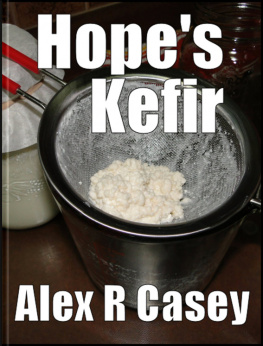Rashelle Johnson - Fermenting vol. 3: Milk Kefir
Here you can read online Rashelle Johnson - Fermenting vol. 3: Milk Kefir full text of the book (entire story) in english for free. Download pdf and epub, get meaning, cover and reviews about this ebook. year: 2013, genre: Home and family. Description of the work, (preface) as well as reviews are available. Best literature library LitArk.com created for fans of good reading and offers a wide selection of genres:
Romance novel
Science fiction
Adventure
Detective
Science
History
Home and family
Prose
Art
Politics
Computer
Non-fiction
Religion
Business
Children
Humor
Choose a favorite category and find really read worthwhile books. Enjoy immersion in the world of imagination, feel the emotions of the characters or learn something new for yourself, make an fascinating discovery.

- Book:Fermenting vol. 3: Milk Kefir
- Author:
- Genre:
- Year:2013
- Rating:3 / 5
- Favourites:Add to favourites
- Your mark:
Fermenting vol. 3: Milk Kefir: summary, description and annotation
We offer to read an annotation, description, summary or preface (depends on what the author of the book "Fermenting vol. 3: Milk Kefir" wrote himself). If you haven't found the necessary information about the book — write in the comments, we will try to find it.
Milk kefir is a powerful probiotic beverage packed full of beneficial bacteria. Its made by adding kefir grains to milk (or many other non-dairy liquids) and letting it ferment for 24 to 48 hours at room temperature. The end result is a tasty beverage the consistency of thin yogurt that can be consumed on its own or mixed with a number of other ingredients to make delicious probiotic foods and beverages.
This helpful guide covers the following items: What Milk Kefir is and how its made.The history of milk kefir.Milk kefir grains and why theyre important.How to care for and store milk kefir grains.The fermentation process.Yogurt vs. kefir.The health benefits of milk kefir.What types of milk work best to make kefir.Kefir culturing vessels.Milk kefir as a sourdough starter. The following milk kefir recipes are included in the book: Traditional milk kefir.Vanilla milk kefir.Sweet maple kefir.Citrus kefir.Cocoa spice kefir.Rise and shine kefir.Kefir protein power shake.Kefir raspberry flaxseed fiber booster.Sweet lavender milk kefir.Sweet raspberry milk kefir.Strawberry banana kefir smoothie.Strawberry lime kefir smoothie.Watermelon slush kefir smoothie.Pina colada kefir.Pumpkin pie kefir.Kefir egg nog.Chai-infused kefir.Kefir chocolate pudding.Kefir peanut banana pudding.Kefir cottage cheese.Kefir banana peach breakfast.Kefir and granola.Fizzy kefir.Kefir creamy fruit juice soda.Kefir Italian Soda.Cinnamon milk kefir.Cocoa cherry fizzy kefir.Strawberry milkshake kefir.Orange creamsicle kefir.Kefir cultured cream.Kefir cultured butter.Kefir cultured ice cream.Cultured cream cheese.Cultured ranch dressing.Kefir fruit dip.Kefir guacamole.Kefir cream frosting (vanilla and chocolate).Coconut milk kefir.Coconut meat kefir spread.Almond milk kefir.Rice milk kefir.Fizzy grape kefir.Soy milk kefir.Kefir sauerkraut. A helpful FAQ that answers many of common questions people have about milk kefir is included at the end of the book.
Here are just some of the topics covered in the FAQ: How fast should kefir grains grow?Do kefir grains need to be washed between batches?How long can kefir be stored in the fridge?I forgot to move my grains to new milk. Can they still be used?What should I do if theres mold at the top of the container?What is the orange or yellow crust on my grains?How much alcohol does kefir contain?Why did the taste and/or texture of my kefir change?Why did my kefir separate? Milk kefir is a great way for most people to add beneficial strains of bacteria to their diet.
Purchase this book and learn how to make milk kefir today.
Rashelle Johnson: author's other books
Who wrote Fermenting vol. 3: Milk Kefir? Find out the surname, the name of the author of the book and a list of all author's works by series.








